Related Research Articles

Ealdred was Abbot of Tavistock, Bishop of Worcester, and Archbishop of York in early medieval England. He was related to a number of other ecclesiastics of the period. After becoming a monk at the monastery at Winchester, he was appointed Abbot of Tavistock Abbey in around 1027. In 1046 he was named to the Bishopric of Worcester. Ealdred, besides his episcopal duties, served Edward the Confessor, the King of England, as a diplomat and as a military leader. He worked to bring one of the king's relatives, Edward the Exile, back to England from Hungary to secure an heir for the childless king.

Salisbury is a cathedral city and civil parish in Wiltshire, England with a population of 41,820, at the confluence of the rivers Avon, Nadder and Bourne. The city is approximately 20 miles from Southampton and 30 miles from Bath.
Athelm was an English churchman, who was the first Bishop of Wells, and later Archbishop of Canterbury. His translation, or moving from one bishopric to another, was a precedent for later translations of ecclesiastics, because prior to this time period such movements were considered illegal. While archbishop, Athelm crowned King Æthelstan, and perhaps wrote the coronation service for the event. An older relative of Dunstan, a later Archbishop of Canterbury, Athelm helped promote Dunstan's early career. After Athelm's death, he was considered a saint, with his feast day being on 8 January.
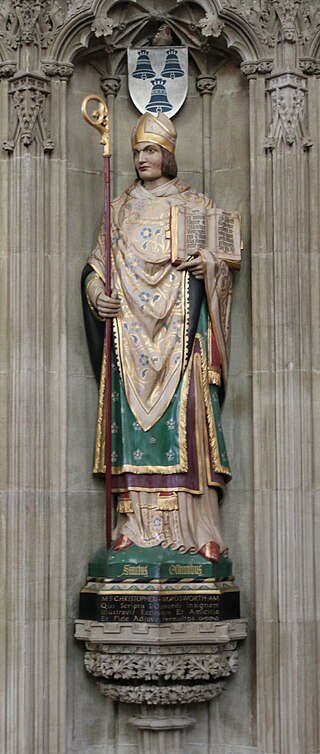
Osmund, Count of Sées, was a Norman noble and clergyman. Following the Norman conquest of England, he served as Lord Chancellor and as the second bishop of Salisbury, or Old Sarum.
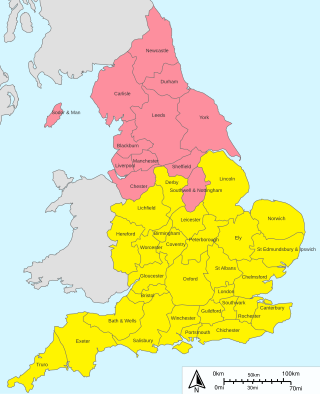
This article traces the historical development of the dioceses and cathedrals of the Church of England. It is customary in England to name each diocese after the city where its cathedral is located. Occasionally, when the bishop's seat has been moved from one city to another, the diocese may retain both names, for example Bath and Wells. More recently, where a cathedral is in a small or little-known town or city, the diocesan name has been changed to include the name of a nearby larger city: thus the cathedral in Southwell now serves the diocese of Southwell and Nottingham, and Ripon Cathedral was in Ripon and Leeds from 1999 until 2014. Cathedrals, like other churches, are dedicated to a particular saint or holy object, or Christ himself, but are commonly referred to by the name of the city where they stand. A cathedral is, simply, the church where the bishop has his chair or "cathedra".

Ramsbury is a village and civil parish in the English county of Wiltshire. The village is in the Kennet Valley near the Berkshire boundary. The nearest towns are Hungerford about 4.5 miles (7.2 km) east and Marlborough about 5.5 miles (8.9 km) west. The much larger town of Swindon is about 12 miles (19 km) to the north.
The Bishop of Ramsbury is an episcopal title used by a suffragan bishop of the Church of England Diocese of Salisbury, in the Province of Canterbury, England. The title takes its name from the village of Ramsbury in Wiltshire, and was first used between the 10th and 11th centuries by the Anglo-Saxon Bishops of Ramsbury; the modern See was erected under the Suffragans Nomination Act 1888 by Order in Council dated 24 October 1973. From the establishment of the Salisbury area scheme in 1981 until its abolition in 2009, the bishops suffragan of Ramsbury were area bishops. The bishop oversees the Wiltshire parts of the diocese, i.e. the Archdeaconries of Sarum and Wiltshire.

Wiltshire is a historic county located in the South West England region. Wiltshire is landlocked and is in the east of the region.

The Use of Sarum is the liturgical use of the Latin rites developed at Salisbury Cathedral and used from the late eleventh century until the English Reformation. It is largely identical to the Roman Rite, with about ten per cent of its material drawn from other sources. The cathedral's liturgy was widely respected during the late Middle Ages, and churches throughout the British Isles and parts of northwestern Europe adapted its customs for celebrations of the Eucharist and canonical hours. The Sarum Rite has a unique ecumenical position in influencing and being authorized for liturgical use by the Roman Catholic Church, Eastern Orthodox Church, as well as the Anglican Communion.
The Bishop of Sherborne is an episcopal title which takes its name from the market town of Sherborne in Dorset, England. The see of Sherborne was established in around 705 by St Aldhelm, the Abbot of Malmesbury. This see was the mother diocese of the greater part of southwestern England in Saxon times, but after the Norman Conquest was incorporated into the new Diocese of Salisbury. The title Bishop of Sherborne is now used by the Church of England for a suffragan bishop in the Diocese of Salisbury.

The Bishop of Hexham was an episcopal title which took its name after the market town of Hexham in Northumberland, England. The title was first used by the Anglo-Saxons in the 7th and 9th centuries, and then by the Roman Catholic Church since the 19th century.
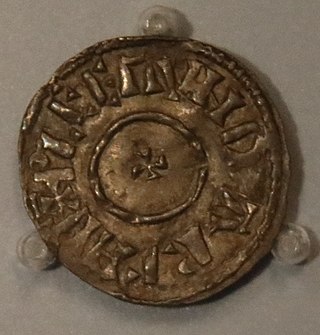
Plegmund was a medieval English Archbishop of Canterbury. He may have been a hermit before he became archbishop in 890. As archbishop, he reorganised the Diocese of Winchester, creating four new sees, and worked with other scholars in translating religious works. He was canonised after his death.
Hygeberht was the bishop of Lichfield from 779 and archbishop of Lichfield after the elevation of Lichfield to an archdiocese some time after 787, during the reign of the powerful Mercian king Offa. Little is known of Hygeberht's background, although he was probably a native of Mercia.
Ælfric of Abingdon was a late 10th-century Archbishop of Canterbury. He previously held the offices of abbot of St Albans Abbey and Bishop of Ramsbury, as well as likely being the abbot of Abingdon Abbey. After his election to Canterbury, he continued to hold the bishopric of Ramsbury along with the archbishopric of Canterbury until his death in 1005. Ælfric may have altered the composition of Canterbury's cathedral chapter by changing the clergy serving in the cathedral from secular clergy to monks. In his will he left a ship to King Æthelred II of England as well as more ships to other legatees.
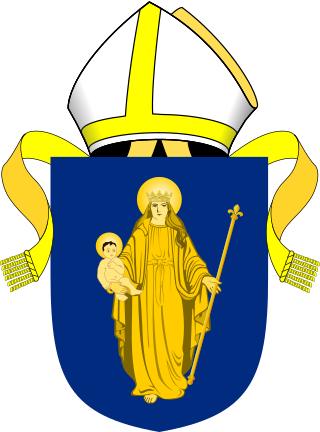
The Bishop of Salisbury is the ordinary of the Church of England's Diocese of Salisbury in the Province of Canterbury. The diocese covers much of the counties of Wiltshire and Dorset. The see is in the City of Salisbury where the bishop's seat is in the Cathedral Church of the Blessed Virgin Mary. The current bishop is Stephen Lake.
Herman (died 1078) was a medieval cleric who served as the Bishop of Ramsbury and of Sherborne before and after the Norman conquest of England. In 1075, he oversaw their unification and translation to Salisbury. He died before the completion of the new cathedral.
Events from the 1070s in England.
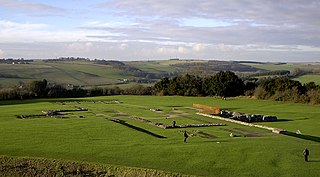
Old Sarum Cathedral was a Catholic and Norman cathedral at old Salisbury, now known as Old Sarum, between 1092 and 1220. Only its foundations remain, in the north-west quadrant of the circular outer bailey of the site, about 2 miles (3.2 km) north of the centre of modern Salisbury, Wiltshire, in the United Kingdom. The cathedral was the seat of the bishops of Salisbury during the early Norman period and the original source of the Sarum Rite.
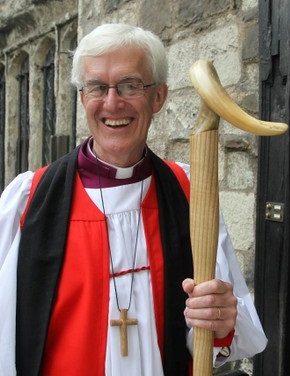
Edward Francis Condry is a retired bishop of the Church of England. He was the suffragan Bishop of Ramsbury in the Diocese of Salisbury, 2012–2018, and Canon Treasurer of Canterbury Cathedral, 2002–2012.
Andrew Paul Rumsey is a British Anglican bishop. Since January 2019, he has served as the Bishop of Ramsbury in the Church of England.
References
- ↑ Barbara Yorke, Frithestan, Oxford Online Dictionary of National Biography, 2004
- ↑ "Catholic Saints" . Retrieved 12 March 2018.
- ↑ "Ramsbury Raven". 21 January 2018. Retrieved 12 March 2018.
- ↑ "Rt Rev. Stephen Wright". Catholic Bishops' Conference. Retrieved 31 August 2023.